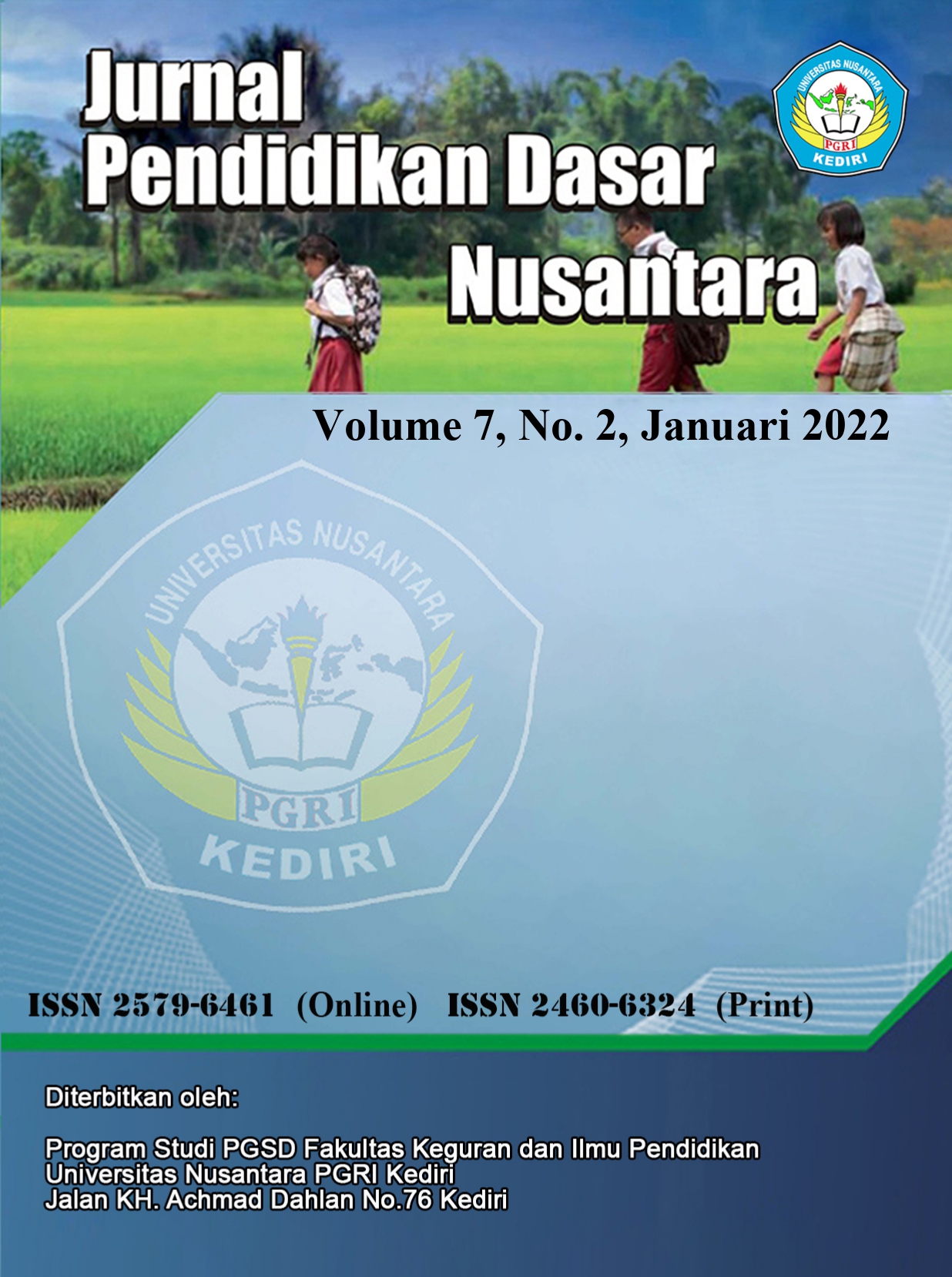The learning innovation of art performance development courses of PGSD students' in UNP Kediri in calon arang story
DOI:
https://doi.org/10.29407/jpdn.v7i2.17262Keywords:
learning innovation, art performance development, creativity.Abstract
This study primarily conducted to find out the learning innovation of art performance development of PGSD students of UNP Kediri in Calon Arang story. This article is the result of qualitative study by art performance approach, by using ethnography method, by focusing on art performance creator which is the students. The data collected were gained by doing an observation, interview, a literature research, and document study. The learning goal of art performance at campus is not only interpreted as creating the students to be the actors, but also focused on developing skill potential and knowledge, and processing students creativity in creating art performance.
Downloads
References
Ahmad. Calon Arang Simbol Perlawanan Kaum Perempuan. Diakses pada Agustus 30, 2021 dari https://indonesiakaya.com/pustaka-indonesia/calon-arang-simbol-perlawanan-kaum-perempuan/
Astriyana, Rina. (2020). Nilai-Nilai Pendidikan Karakter Pada Naskah Drama Karangan Siswa Kelas Viii A Semester 1 Smp Negeri 1 Sumberwringin Tahun Pelajaran 2018/2019. Skripsi, Universitas Muhamadiyah Jember. Diakses dari http://repository.unmuhjember.ac.id/6815/
Hayati, Fitriah. (2016). Peningkatan Kreativitas Bermain Musik Anak Usia 5-6 Tahun Dengan Menggunakan Barang Bekas. Jurnal Pendidikan anak Bunnaya 1(2), 84-99
Irawan, Indra. (2020). Pendidikan Seni Sebagai Wahana Pengembangan Kreatifitas Siswa. Diakses dari https://bdkpadang.kemenag.go.id/berita/pendidikan-seni-sebagai-wahana-pengembangan-kreatifitas-siswa
Mahendra, PA., Gunatama G., & Suandi, M. (2017). Strategi Dan Proses Kreatif Produksi Pementasan Drama Dalam Pembelajaran Drama Kelas Xi Sma Negeri Bali Mandara. e-Journal Jurusan Pendidikan Bahasa dan Sastra Indonesia 7(2), 1-11. Diaksesdari https://ejournal.undiksha.ac.id/index.php/JJPBS/article/viewFile/14514/8869
Mansyur, Marwati., Rosinar Siregar. (2008). Kreativitas Mahasiswa PGSD Dalam Cipta Seni. Jurnal Perspektif Ilmu Pendidikan 18(IX), 57-66
Masunah, Juju. (2004). Berbagai pengalaman lapangan di tingkat sekolah dasar dan menengah.Surakarta: Pusat Study Budaya dan Perubahan Sosial, Universitas Muhammadiyah Surakarta.
Munandar, U. (1999). Kreativitas dan Keberbakatan. Strategi Mewujudkan Potensi Kreatif dan Bakat. Jakarta: PT. Gramedia Pustaka utama
Ratna, N. K. (2009). Teori, Metode, dan Teknik Penelitian Sastra. Yogyakarta: Pustaka Pelajar
Poespoprodjo, P. (1987). Interpretasi. Bandung: Remadja Karya
Sari, KP., Neviyarni., & Irdamurni. (2019). Pengembangan Kreativitas Dan Konsep Diri Anak SD. Jurnal Ilmiah Pendidikan Dasar 2(1), 44-50.
Setiawan, Budiana. (2016). Kreativitas Dan Inovasi Seni Pertunjukan Sebagai Jembatan Membangun Multikultur: Studi Kasus Masyarakat Kota Mataram. Jurnal Penelitian Sejarah dan Nilai Tradisional 23(1), 1-14
Soetopo, Soengkowo. (2015). Pembelajaran Seni di Sekolah Dasar. Jurnal Inovasi Sekolah Dasar 2(1), 25-32
Suhaya. (2016). Pendidikan Seni Sebagai Penunjang Kreatifitas. Jurnal Pendidikan dan Kajian Seni 1 (I), 1-15
Sujamto. (1992). Wayang dan Budaya Jawa. Semarang: Dahara Prize.
Sunarto. (2018). Pengembangan Kreativitas-Inovatif Dalam Pendidikan Seni Melalui Pembelajaran Mukidi. Jurnal Refleksi Edukatika 8(2), 107-113
Suyadi., & Hasanah N. (2020). Pengembangan Kreativitas Dan Konsep Diri Anak Sekolah Dasar. Jurnal Riset Pendidikan Dasar 03(2), 162-169
Trianingsih, R. (2018). Pengantar Praktik Mendidik Anak Usia Sekolah Dasar. Journal Al Ibtida 3(2). 197-211
Wahyudi,.Sari ATR., & Aka K. (2021). Cipta Karya Seni Pertunjukan Teater Anak Berbasis Kebudayaan Panji (Best Practice Penciptaan Karya Seni Pertunjukan Pada Masa Pandemi Covid-19). Jurnal Pendidikan Dasar Nusantara 6(2), 180-196
Wiarsih, C., & Irawan, D. (2017). Upaya Meningkatkan Kreativitas Dan Kemampuan Mengapresiasi Drama Melalui Pementasan Drama. Jurnal Ilmiah Kependidikan 10(2), 1-21
Downloads
Published
Issue
Section
License
Authors who publish with this journal agree to the following terms:
- Copyright on any article is retained by the author(s).
- The author grants the journal, the right of first publication with the work simultaneously licensed under a Creative Commons Attribution License that allows others to share the work with an acknowledgment of the work’s authorship and initial publication in this journal.
- Authors are able to enter into separate, additional contractual arrangements for the non-exclusive distribution of the journal’s published version of the work (e.g., post it to an institutional repository or publish it in a book), with an acknowledgment of its initial publication in this journal.
- Authors are permitted and encouraged to post their work online (e.g., in institutional repositories or on their website) prior to and during the submission process, as it can lead to productive exchanges, as well as earlier and greater citation of published work.
- The article and any associated published material is distributed under the Creative Commons Attribution-ShareAlike 4.0 International License

































